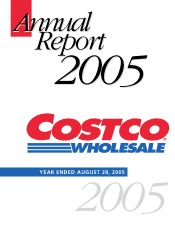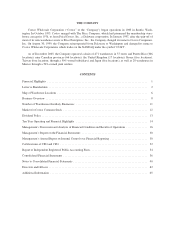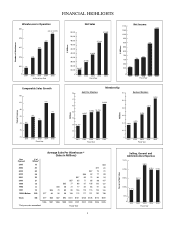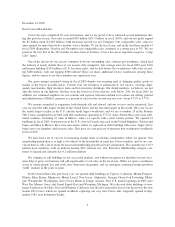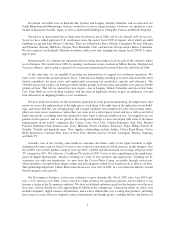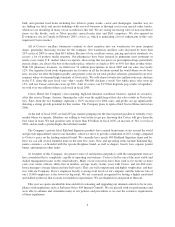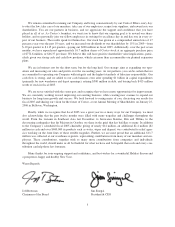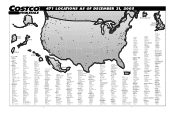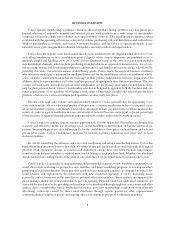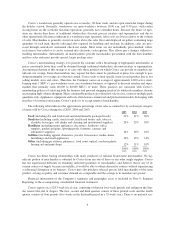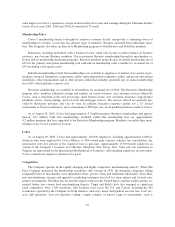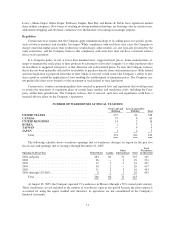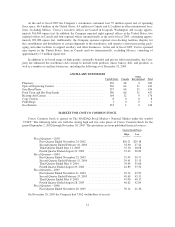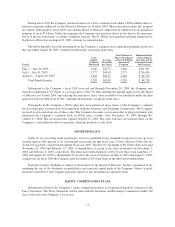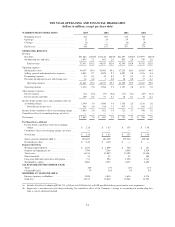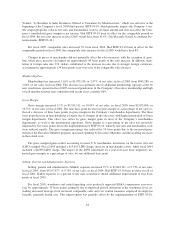Costco 2005 Annual Report Download - page 10
Download and view the complete annual report
Please find page 10 of the 2005 Costco annual report below. You can navigate through the pages in the report by either clicking on the pages listed below, or by using the keyword search tool below to find specific information within the annual report.
Costco’s warehouses generally operate on a seven-day, 69-hour week, and are open somewhat longer during
the holiday season. Generally, warehouses are open weekdays between 10:00 a.m. and 8:30 p.m., with earlier
closing hours on the weekend. Gasoline operations generally have extended hours. Because the hours of oper-
ation are shorter than those of traditional wholesalers, discount grocery retailers and supermarkets and due to
other operational efficiencies inherent in a warehouse-type operation, labor costs are lower relative to the volume
of sales. Merchandise is generally stored on racks above the sales floor and displayed on pallets containing large
quantities of each item, thereby reducing labor required for handling and stocking. In addition, sales are proc-
essed through centralized, automated check-out stands. Most items are not individually price-marked; rather,
each item is bar-coded so it can be scanned into electronic cash registers. This allows price changes without re-
marking merchandise. Substantially all manufacturers provide merchandise pre-marked with the item numbers
and bar codes and many provide special, larger package sizes.
Costco’s merchandising strategy is to provide the customer with a broad range of high quality merchandise at
prices consistently lower than could be obtained through traditional wholesalers, discount retailers or supermarkets.
An important element of this strategy is to carry only those products on which Costco can provide its members sig-
nificant cost savings. Items that members may request but that cannot be purchased at prices low enough to pass
along meaningful cost savings are often not carried. Costco seeks to limit specific items in each product line to fast
selling models, sizes and colors. Therefore, the Company carries an average of approximately 4,000 active stock-
keeping units (“SKU’s”) per warehouse in its core warehouse business, as opposed to discount retailers and super-
markets that normally stock 40,000 to 60,000 SKU’s or more. These practices are consistent with Costco’s
membership policies of satisfying both the business and personal shopping needs of its wholesale members, thereby
encouraging high volume shopping. Many consumable products are offered for sale in case, carton or multiple-pack
quantities only. Appliances, equipment and tools often feature commercial and professional models. In keeping with
its policy of customer satisfaction, Costco’s policy is to accept returns of merchandise.
The following table indicates the approximate percentage of net sales accounted for by each major category
of items sold by Costco during fiscal 2005, 2004 and 2003:
2005 2004 2003
Food (including dry and fresh foods and institutionally packaged foods) .... 31% 31% 30%
Sundries (including candy, snack foods, health and beauty aids, tobacco,
alcoholic beverages, soft drinks and cleaning and institutional supplies) . . . 29% 29% 30%
Hardlines (including major appliances, electronics, hardware, office
supplies, garden and patio, sporting goods, furniture, cameras and
automotive supplies) ........................................... 16% 16% 16%
Softlines (including apparel, domestics, jewelry, housewares, media, home
furnishings and small appliances) ................................. 12% 13% 14%
Other (including gas stations, pharmacy, food court, optical, one-hour photo,
hearing aid and print shop) ....................................... 12% 11% 10%
100% 100% 100%
Costco has direct buying relationships with many producers of national brand name merchandise. No sig-
nificant portion of merchandise is obtained by Costco from any one of these or any other single supplier. Costco
has not experienced difficulty in obtaining sufficient quantities of merchandise, and believes that if any of its
current sources of supply became unavailable, it would be able to obtain alternative sources without experiencing
a substantial disruption of its business. Costco may also purchase selected private label merchandise of the same
product, as long as quality and customer demand are comparable and the savings to its members are greater.
Financial information of the Company’s segments and geographic areas is included in Note 9, Segment
Reporting, to the accompanying consolidated financial statements.
Costco reports on a 52/53-week fiscal year, consisting of thirteen four-week periods and ending on the Sun-
day nearest the end of August. The first, second and third quarters consist of three periods each, and the fourth
quarter consists of four periods (five weeks in the thirteenth period in a 53-week year). There is no material sea-
9

